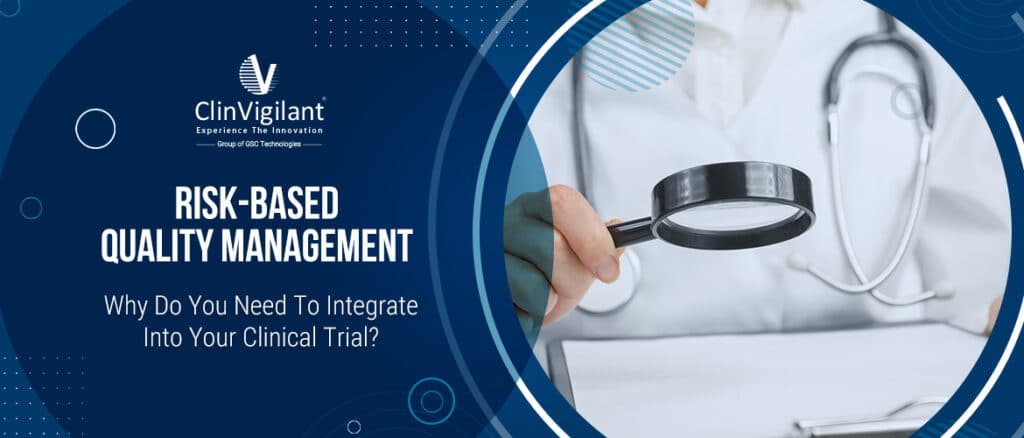Risk-Based Quality Management In Clinical Trials
Clinical trials are crucial for the development of new drugs, medical devices and other therapies. They represent an investment by pharmaceutical companies into their research and development (R&D) pipeline. However, clinical trials can be costly and time-consuming processes which can fail if not executed properly. One way to mitigate this risk is through risk-based quality management (RBQM). This article will discuss the role RBQM plays in reducing costs while improving success rates during the course of a clinical trial.

The purpose of Risk-Based Quality Management (RBQM)
RBQM is a way to manage the risks associated with clinical trials. The primary objective of RBQM is to improve the quality of data obtained from clinical trials and thus ensure that they meet their intended purpose, in this case, reducing the risk of death or serious illness among participants.
In order for RBQM strategies to be effective, they must be implemented within an overall system that includes all phases of a clinical trial’s development cycle: planning, implementation and monitoring/evaluation.
What are the benefits of Risk-Based Quality Management (RBQM)?
In the past, clinical trials were designed to test specific hypotheses about a particular treatment. The results of such studies were often used to draw conclusions about the effectiveness or otherwise of that treatment.
However, with the introduction of risk-based quality management (RBQM), investigators can now use their data more efficiently and productively by following a structured approach that allows them to make informed decisions based on the outcomes from those trials. This will lead them down a path toward better quality data collection, analysis, and conclusion generation—all while reducing costs associated with creating new drugs or treatments.
How does Risk-Based Quality Management (RBQM) work?
The risk-based approach to quality management is a systematic way of identifying, assessing, and mitigating risks in clinical trials. This formalized process for managing risks that is used to ensure the safety of patients who participate in clinical trials.
The process begins by identifying all the potential hazards associated with your study (e.g., side effects) and then determining which ones pose the greatest threat to patient safety.
Next you apply measures to reduce those hazards so they can be managed effectively while still meeting regulatory requirements—for example:
Risk management plans will identify how best to minimize potential harms caused by adverse events related to your research drug; these plans should include steps such as providing adequate training for staff members involved with administering anesthetic agents or monitoring patients during procedures involving invasive instruments that may cause pain or discomfort when used incorrectly; initiating protocols designed specifically for each type of device being used (e.g., ventilators); avoiding unnecessary tests when possible so there’s less chance something unexpected could happen during surgery); etc…
When does Risk-Based Quality Management (RBQM) start?
RBQM is a continuous process that starts with the planning of a clinical trial and continues throughout the conduct of a study. At every stage, risk mitigation strategies should be considered to reduce or eliminate harms to participants.
During Phase I and II trials, investigators must consider how to identify risks early on in order for them not only to avoid harm but also continue advancing research without increasing cost or time delays.
How do you identify risks in a clinical trial?
To identify the risks in a clinical trial, you need to know who is involved in it and what kinds of things could go wrong. For example, if an investigator has been studying a drug for months or years and has decided that it’s ready for human trials, then they will want to make sure their data is as accurate as possible before they start enrolling people into their study.
This is especially important because otherwise there’s no way anyone would be able to tell if anything happened during those months or years of testing—or even if anything did happen at all!
In addition to identifying potential problems with your study design through careful planning beforehand (and during), you also have several tools available at hand should something bad happen during your clinical trial:
Audits: Audits are done periodically throughout the course of conducting activities related with producing results from ones studies; these audits help ensure compliance with regulatory requirements like Good Clinical Practice guidelines established by FDA etc., among others so that such organizations can avoid fines resulting from non-compliance issues up front instead having problems crop up later down road after completion date set by officials overseeing them)
How do you assess risks?
To assess risk, you will need to use a risk assessment tool. There are many different types of tools available that can be used for this purpose, but some popular ones include:
- The Risks and Benefits Analysis (RBA) Tool
- The Risk Assessment Matrix (RAM)
- The Checklist for Risk Assessment Methods
How do you prioritize risks in a trial?
The first step is to prioritize risks based on their severity and likelihood of occurrence. For example, if you’re doing a trial and there’s a risk of the study drug causing heart palpitations in patients who take it, then this would be considered extremely high-risk because it could lead to serious adverse events such as cardiac arrest or death.
You might also consider whether there are other drugs available for treating your condition that have similar side effects and which one you should use in this particular study (or if you should even be doing it at all).
Next, look at how much impact each risk has on your trial: Is its impact large enough? If so then it’s worth taking into account when prioritizing risks; otherwise not much thought needs go into them since they won’t have any major impact on participant outcomes anyway! Finally consider how much potentially negative impact these same risks may have on your sponsor or patient population—if someone dies after taking a medication during clinical trials then this could cause problems for everyone involved: sponsors lose money; patients suffer financially because they didn’t get treated/reimbursed properly while being involved with research projects like yours; etcetera…
How do you mitigate risks in a clinical trial?
Risk mitigation is the process of reducing the likelihood of an adverse event occurring. As with all processes, risk mitigation includes risk assessment and risk acceptance (the action taken).
Risk avoidance involves taking measures to reduce or eliminate the potential for harm from a given situation. For example, if you’re going to drive on a busy highway, you may choose not have your car tuned up before starting out.
This will avoid having any unnecessary repairs needed while driving so there’s less chance that something could go wrong during operation or maintenance down the road—and therefore less chance that your vehicle could become unsafe or unroadworthy at some point in time (which would mean being towed away from where ever it was parked).
The same concept applies here: if we want our clinical trial protocol set up properly then we need do everything possible within reason (and budget) since there always seems like there’s always something else worth worrying about when it comes down
Risk-Based Quality Management is the new way to conduct clinical trials.
It’s an approach to quality management that focuses on risk, not risk-free. The idea behind RBQM is that you can’t manage against 100% of the risks in your study; instead, you need to assess them and determine how much of a chance they represent for each patient cohort and intervention.
Conclusion
RBQM is a methodology that can help ensure the safety and validity of your clinical trial. RBQM is an extension of traditional quality management techniques, but it takes risk assessment to the next level by using information from all aspects of the clinical trial process to prioritize risks and mitigate them.
It also allows you to determine when to stop enrolling new patients into a study based on past results and how much time you believe will be needed for each phase as well as whether more subjects are needed for that phase in order for it to be successful (known as “blinding”). These tools have been used successfully in many trials worldwide, improving patient safety while saving time by not repeating processes over again until they yield success!
Clinvigilant’s Risk-Based Quality Management
Clinvigilant’s quality management system considers clinical trial as a whole for risk-based assessment from the perspectives of the clinical trial design, conduct, analysis, report, regulatory perspectives as well as archiving. Our interdisciplinary team is adept in clinical knowledge, project management, data management, IT support as well as biostatistics, pharmacovigilance and regulatory experts.
Do You Have Any Questions Or Need Any Support For Your Clinical Trial?
Clinvigilant’s team assesses the inherent risks associated with the project, external risks that may pose, and strategies to mitigate these risks. Quality is Clinvigilant’s fundamental principle and never compromises the quality of studies and the safety of participants. Provide the details to connect with us and explore our services.

